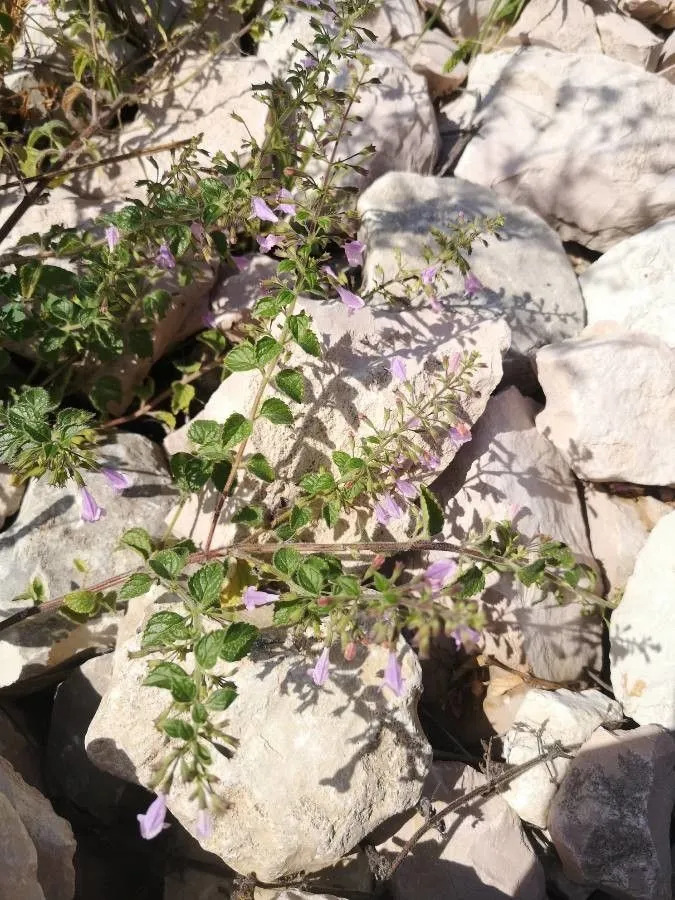
Author: Kuntze
Bibliography: Revis. gen. pl. 2:515. 1891
Year: 1891
Status: accepted
Rank: species
Genus: Clinopodium
Vegetable: False
Observations: C. Europe, Medit. to N. Iran
Lesser calamint, scientifically known as Clinopodium nepeta, is a perennial herbaceous plant that belongs to the diverse family of Lamiaceae. This aromatic plant is native to Central Europe and the Mediterranean region, extending its range to Northern Iran. The plant has been documented in botanical literature as early as 1891 by Kuntze in the “Revisio Generum Plantarum”.
Clinopodium nepeta thrives in sunny, well-drained locations and is commonly found in dry meadows, rocky slopes, and roadsides. It typically reaches a height of 30 to 60 centimeters and features small, ovate leaves with a pleasantly minty fragrance. During its blooming season, which spans from late spring to early fall, lesser calamint produces clusters of small, tubular flowers. These flowers, usually lavender or pink, attract a variety of pollinators, including bees and butterflies, making it an excellent choice for wildlife gardens.
Due to its hardy nature and low maintenance requirements, lesser calamint is often used in garden borders, rock gardens, and herb gardens. Its aromatic leaves are not only decorative but also have been traditionally used in culinary practices and for medicinal purposes. The leaves can be harvested and used fresh or dried to add a subtle minty flavor to dishes or to brew herbal teas.
Beyond its ornamental and culinary applications, lesser calamint has long been appreciated for its medicinal properties. Historically, it has been used as a remedy for digestive issues, colds, and respiratory problems, thanks to its carminative and diaphoretic properties.
Despite its many uses, care should be taken when planting lesser calamint, as it can become quite prolific under favorable conditions, potentially outcompeting other plants in mixed herbaceous borders.
In summary, Clinopodium nepeta, or lesser calamint, is a versatile and robust plant with a rich cultural history and a variety of uses. Its attractive flowers and fragrant leaves make it a valuable addition to gardens, while its traditional uses highlight its importance in herbal medicine and culinary arts.
Dan: bjergmynte
Deu: katzen-bergthymian, kleinblütige bergminze, echte bergminze
Eng: lesser calamint
Fra: calament, menthe de montagne
Ita: mentuccia commune
Swe: stenkyndel
En: Lesser calamint, Mountain Balm, Mountain Mint
Ar: فوذنج جبلي
Cs: Marulka šantovitá
Da: Bjergmynte
Nl: Kleinbloemige Steentijm
Fi: Kivikkokäenminttu, Kivikkomäkiminttu
Fr: Calament, Menthe de montagne, Calament faux népéta, Calament népéta, Sarriette calament, Sarriette faux népéta, Sarriette népéta, Baume sauvage, Calament à petites fleurs, Calament de montagne, Calament glanduleux, Fausse Marjolaine, Pouliot de montagne
Gl: Nébeda
De: Katzen-Bergthymian, Echte Bergminze, Kleinblütige Bergminze, Drüsige Bergminze, Katzenminzenartige Bergminze
It: Mentuccia commune, Mentuccia, Mentuccia comune, Nepetella, Poleggio selvatico
Fa: زیبانعنای دارویی
Pl: Klinopodium kocimiętkowate
Sr: Дивљи босиљак
Sk: Marulka kocúrnik
Es: Calaminta de montaña, Calaminta menor
Sv: Stenkyndel
© copyright of the Board of Trustees of the Royal Botanic Gardens, Kew.
© copyright of the Board of Trustees of the Royal Botanic Gardens, Kew.
Taken Sep 23, 2018 by Pep Secem (cc-by-sa)
Taken Sep 23, 2018 by Pep Secem (cc-by-sa)
Taken Oct 27, 2021 by Gianni Del Bufalo (cc-by-sa)
Taken Oct 8, 2017 by Andrew Watts (cc-by-sa)
Taken Nov 20, 2021 by Angelos (cc-by-sa)
Taken Sep 7, 2019 by Romain HERRERA (cc-by-sa)
Taken Oct 21, 2021 by Llandrich anna (cc-by-sa)
Taken Aug 8, 2021 by manuseitz (cc-by-sa)
Taken May 15, 2020 by Claudine BRUS née MARTIN (cc-by-sa)
Taken Oct 27, 2021 by Gianni Del Bufalo (cc-by-sa)
Taken Nov 8, 2018 by Lorenzo Varela (cc-by-sa)
Taken Sep 29, 2021 by vero (cc-by-sa)
Taken Sep 29, 2021 by vero (cc-by-sa)
Taken Oct 27, 2021 by Gianni Del Bufalo (cc-by-sa)
Taken Oct 8, 2017 by Andrew Watts (cc-by-sa)
Taken Oct 7, 2022 by Francois Mansour (cc-by-sa)
Taken Sep 22, 2021 by Christoph Zirwes (cc-by-sa)
Taken Oct 3, 2020 by Sergey Shatrov (cc-by-sa)
Taken Sep 27, 2021 by Manuëlle (cc-by-sa)
Taken Oct 27, 2021 by Gianni Del Bufalo (cc-by-sa)
Taken Jan 1, 1970 by Photoflora – L’Abbé COSTE (©)
Taken Jan 1, 1970 by Photoflora – L’Abbé COSTE (©)
Taken Sep 17, 2020 by Alain Bigou (cc-by-sa)
Taken Sep 11, 2022 by Ludovic Lavigne (cc-by-sa)
Taken Oct 8, 2017 by Andrew Watts (cc-by-sa)
Taken Oct 26, 2015 by Tela Botanica − Liliane ROUBAUDI (cc-by-sa)
Taken Oct 26, 2015 by Tela Botanica − Liliane ROUBAUDI (cc-by-sa)
Taken Oct 26, 2015 by Tela Botanica − Liliane ROUBAUDI (cc-by-sa)
Taken Oct 26, 2015 by Tela Botanica − Liliane ROUBAUDI (cc-by-sa)
Taken Oct 8, 2022 by Stéphane Mars (cc-by-sa)
Growth habit: Forb/herb, Subshrub
Family: Myrtaceae Author: (F.Muell.) K.D.Hill & L.A.S.Johnson Bibliography: Telopea 6: 402 (1995) Year: 1995 Status:…
Family: Rubiaceae Author: Pierre ex A.Froehner Bibliography: Notizbl. Bot. Gart. Berlin-Dahlem 1: 237 (1897) Year:…
Family: Sapindaceae Author: Koidz. Bibliography: J. Coll. Sci. Imp. Univ. Tokyo 32(1): 38 (1911) Year:…
Family: Asteraceae Author: A.Gray Bibliography: Pacif. Railr. Rep.: 107 (1857) Year: 1857 Status: accepted Rank:…
Family: Fabaceae Author: Medik. Bibliography: Vorles. Churpfälz. Phys.-Ökon. Ges. 2: 398 (1787) Year: 1787 Status:…
Family: Aspleniaceae Author: (Cav.) Alston Bibliography: Bull. Misc. Inform. Kew 1932: 309 (1932) Year: 1932…